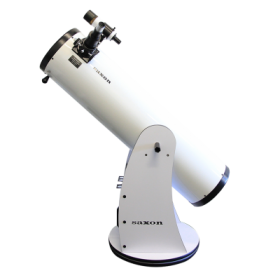You may also be interested in the following product(s)
-

saxon 10 Inch DeepSky Dobsonian Telescope
AUD $1,199.00 -

Celestron Starsense Explorer 8 Inch Dobsonian
AUD $1,499.00 -

saxon 8 Inch DeepSky CT Dobsonian Telescope
AUD $999.00 -

Celestron StarSense Explorer 10 Inch Dobsonian
Regular Price: AUD $2,049.00
Special Price AUD $1,999.00
-

Explore Scientific - Generation II - 10-inch Truss Tube Dobsonian Telescope
AUD $1,779.00 -

saxon 10 Inch DeepSky CT Dobsonian Telescope
AUD $1,449.00
Details
The saxon 8" DeepSky Dobsonian Telescope is the perfect partner to begin your astronomy adventure with. This affordable telescope comes with a "paraboloidal" primary mirror to eliminate spherical aberration and a four-arm, secondary-mirror bracket with fine supports (0.5mm thick) to reduce diffraction spikes and light loss.
This telescope comes with an aperture (mirror diameter) of 203mm and a focal length of 1200mm in a 235 mm diameter tube.
NOTE: This is not a telescope that sits on a table and the base holding the telescope sits on the ground. Dobsonian reflector telescopes do not use tripods.
This scope features quality parts and accesories - the special roller-bearing construction, Crayford focuser, eyepieces and finderscope are all designed to aid with your observing experience.
Once assembled and with a little practice, you'll soon be able to find and view the rocky surfaces of the Moon, planets in the Solar System as well as deep sky objects such as star clusters, double stars, nebulae and even galaxies.
The saxon 8" DeepSky Dobsonian Telescope requires no additional tools during assembly and is incredibly easy to use, making it the perfect scope for beginner astronomers.
The DeepSky Dobsonian Telescopes series comes in four sizes - 6", 8", 10" and 12".
What is Dobsonian Telescope and Why the Tension Control Handle?
A simple, elegant form of an alt-azimuth mount made to carry a Newtonian reflector was popularized by John Dobson in the late 1970's. The Dobsonian mounted telescope is popular among amateur astronomers and telescope makers because of its simplicity. In its simplest form, the Dobsonian mount consists of a box which allows the optical tube assembly to pivot in altitude, while the box itself is swivelled on a base in azimuth.
The Dobsonian mount usually relies on the friction between the side bearings on the optical tube of the telescope and a frictional material on the saddle to hold the optical tube in place. If there is too much friction, the telescope is difficult to move to center an object in the field of view. If there is too little friction, the telescope will not stay where it is positioned. This makes stabilizing the optical tube of the telescope difficult when using a Dobsonian mount, especially when accessories, such as a finderscope or an eyepiece, are added to the optical tube. As long as the amount of friction is at an appropriate level, and therefore stabilization of the optical tube is achieved, the telescope can remain in its desired position to view an object and maintain its position even when the mount is rotated.
The devices for stabilizing a telescope on the Dobsonian mount currently available include: a sliceable weight to counter balance the weight of the telescope, a friction lock that must be adjusted to inhibit movement of the telescope, and a spring attached between the telescope tube and mount to aid in stabilization.
These devices are inconvenient to use because they do not provide a simple and user-friendly way to adjust the friction. The objective of the saxon Tension Control Handle invention is to provide a tension adjuster that users can easily turn to add or reduce tension, thereby increasing or decreasing the friction between the optical tube and the sideboard of the mount.
By providing such a tension adjuster, the telescope does not need to be balanced in order to stay in position. The tension adjuster can be tightened such that the optical tube can stay in a position but can still be moved when prompted to adjust the position of the optical tube. Alternatively, the tension adjuster can be completely tightened to lock the optical tube in position.
Additional Information
| Specifications |
|
|---|



